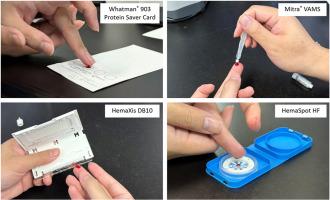超高效液相色谱-串联质谱法检测运动中糖皮质激素微采样干血点装置的分析和可用性比较
IF 6
2区 化学
Q1 CHEMISTRY, ANALYTICAL
引用次数: 0
摘要
干血点(DBS)取样在反兴奋剂检测中具有主要优势,包括最小的侵入性、增强的稳定性和简化的物流。虽然DBS已经在2020年东京奥运会和2022年北京奥运会等重大赛事中引入,但专门用于兴奋剂控制中糖皮质激素检测的商用DBS设备的全面评估仍然有限。本研究评估了四种DBS设备- whatman®903 Protein Saver Card (Card), HemaSpot HF (Fan), Mitra®VAMS (Tip)和HemaXis DB10 (Chip) -用于使用超高效液相色谱-串联质谱法检测六种常用的糖皮质激素。分析评价包括日内/日内精密度、回收率、基质效应、红细胞压积(Hct)效应以及与加标全血的一致性。可用性由20名训练有素的参与者使用系统可用性量表(SUS)和11点数字量表进行评估。Tip获得了最高的回收率(83-108%),最高的可用性得分(SUS: 85.0±8.2;数值:8.6±0.9),并且不受Hct变化的影响。与全血相比,Chip具有良好的分析性能和最小的偏差。相比之下,Card和Fan表现出较低的回收率和较高的变异性,特别是甲基强的松龙和曲安奈德。基质效应主要是抑制性的,尽管范显示了对某些分析物的增强。Fan也有最低的可用性评级和最高的抽样失败率。总的来说,Tip展示了分析可靠性和用户可用性的最有利组合。芯片也显示出精确定量的希望。这些结果强调了选择合适的DBS设备和优化糖皮质激素分析方案的重要性。进一步的验证和纵向研究是必要的,以支持DBS在常规反兴奋剂计划中的实施。本文章由计算机程序翻译,如有差异,请以英文原文为准。

Analytical and usability comparison of microsampling dried blood spot devices for glucocorticoid detection in sports using ultra-high-performance liquid chromatography–tandem mass spectrometry
Dried blood spot (DBS) sampling offers key advantages in anti-doping testing, including minimal invasiveness, enhanced stability, and simplified logistics. While DBS has been introduced in major events such as the Tokyo 2020 and Beijing 2022 Olympics, comprehensive evaluations of commercial DBS devices specifically for glucocorticoid detection in doping control remain limited. This study evaluated four DBS devices—Whatman® 903 Protein Saver Card (Card), HemaSpot HF (Fan), Mitra® VAMS (Tip), and HemaXis DB10 (Chip)—for detecting six commonly used glucocorticoids using ultra-high-performance liquid chromatography–tandem mass spectrometry.Analytical evaluations included intra-/inter-day precision, recovery, matrix effects, Hematocrit (Hct) effects, and agreement with spiked whole blood. Usability was assessed by 20 trained participants using the System Usability Scale (SUS) and an 11-point numeric scale. Tip achieved the highest recovery (83–108%), top usability scores (SUS: 85.0 ± 8.2; numeric: 8.6 ± 0.9), and was not affected by the Hct variation. Chip showed good analytical performance and the least bias compared to whole blood. In contrast, Card and Fan exhibited lower recoveries and higher variability, particularly for methylprednisolone and triamcinolone acetonide. Matrix effects were mainly suppressive, though Fan showed enhancement for select analytes. Fan also had the lowest usability ratings and the highest sampling failure rate.Overall, Tip demonstrated the most favorable combination of analytical reliability and user usability. Chip also showed promise for accurate quantification. These results highlight the importance of selecting appropriate DBS devices and optimizing protocols for glucocorticoid analysis. Further validation and longitudinal studies are warranted to support DBS implementation in routine anti-doping programs.
求助全文
通过发布文献求助,成功后即可免费获取论文全文。
去求助
来源期刊

Analytica Chimica Acta
化学-分析化学
CiteScore
10.40
自引率
6.50%
发文量
1081
审稿时长
38 days
期刊介绍:
Analytica Chimica Acta has an open access mirror journal Analytica Chimica Acta: X, sharing the same aims and scope, editorial team, submission system and rigorous peer review.
Analytica Chimica Acta provides a forum for the rapid publication of original research, and critical, comprehensive reviews dealing with all aspects of fundamental and applied modern analytical chemistry. The journal welcomes the submission of research papers which report studies concerning the development of new and significant analytical methodologies. In determining the suitability of submitted articles for publication, particular scrutiny will be placed on the degree of novelty and impact of the research and the extent to which it adds to the existing body of knowledge in analytical chemistry.
 求助内容:
求助内容: 应助结果提醒方式:
应助结果提醒方式:


